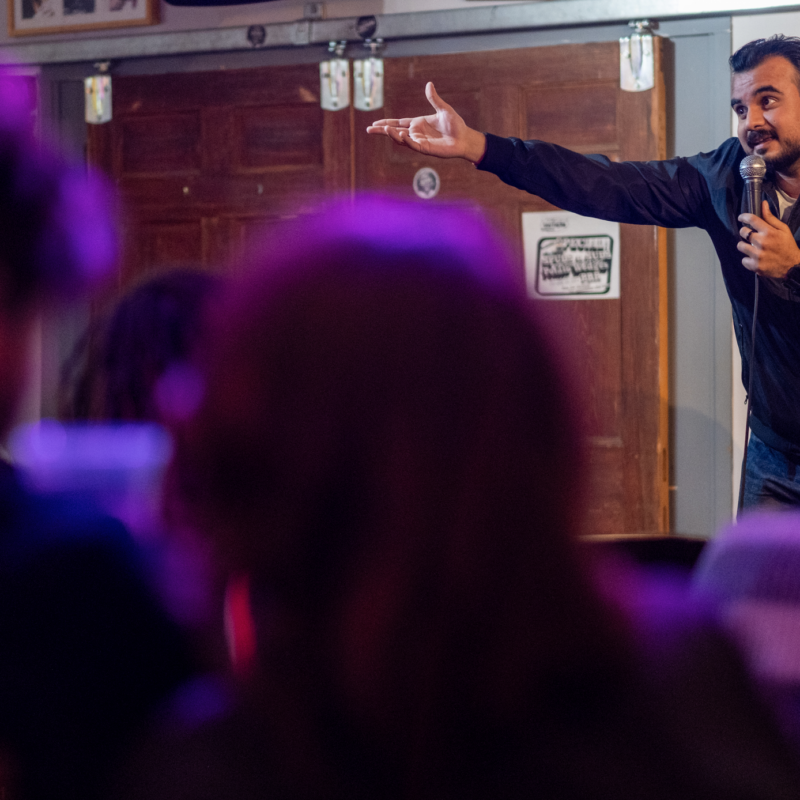Home movies have long been the stuff of baby’s first steps, the kid’s piano recital, and trips to Disneyland. But for academics, all the other stuff captured by amateur filmmakers—where the baby’s walking, who’s sitting where at the recital, and who’s in costume at Disneyland—is emerging as a valuable part of the historical record. And for cinephiles, home movies are increasingly gaining recognition as modern folk art.
|
A still from one of 44 films acquired by UVA’s Special Collections library in 2007 from the family of Ralph W. Feil, a Kodak employee who captured valuable images of Charlottesville—and his family—on recently-discontinued Kodachrome stock. |
So it was a pleasant surprise, when looking through listings for Preservation Week at the end of April, to find a screening of two local home movies, recently restored at UVA’s Special Collections library, that were as historically interesting as they were aesthetically. They were made by Ralph W. Feil, a longtime local who worked for Eastman Kodak beginning in the 1930s, and through his work received free rolls of Kodachrome, the vibrant color reversal film that was discontinued in 2009. (The Magnum photographer Steve McCurry will talk about shooting the last-ever roll of Kodachrome next month, at the LOOK3 Festival of the Photograph.)
The restored films capture images of Charlottesville you’re unlikely to find anywhere else in color: A bustling Downtown Mall when cars still drove through it, a Pantops when cows roamed it, and, most impressive, aerial footage of a leafier Charlottesville and the Rotunda. The films screened were just two of the 44 films, shot between 1939 and the 1950s, that the UVA library chose for preservation and formally acquired from Feil’s granddaughter, Michaux Hood, in 2007.
After decades in a closet, the films were well-labeled and still in their original Kodak boxes. But most people don’t have the tools needed to preserve film in the long term. “Humidity is particularly bad for film, and we have plenty of that here,” says Steven Villereal, an audiovisual conservator with UVA’s Special Collections library. “They were severely shrunken, which happens when plasticizers and conditioners in the film evaporate, and the acetate film base was starting to seriously deteriorate.” Yes, that’s as bad as it sounds.
“To have color moving images of this vintage depicting bustling scenes on Main Street and Market Street is pretty special,” says Villereal. “Consulting with staff in Special Collections, we discovered that they don’t possess any color photographs of these locations from this time period.” So Villereal led the time-consuming process of cleaning Feil’s films, sending them to a lab to create negatives, and creating new ones, which are now stored in special boxes at cool temperatures in the library. (Villereal says they didn’t just digitally transfer the films because nobody knows what’s going to happen with a hard drive when you take it off the shelf in a century.)
“Aside from their uniqueness as documents of local history, they are just beautiful, well-photographed films that are engaging to watch,” says Villereal of the films. Which is another reason why old footage of family milestones, like Feil’s, are of increasing interest to people who aren’t related to the filmmakers. The Center for Home Movies founded a Home Movie Day in 2002, an annual celebration of amateur films. Since then, the day has brought to light a series of historically important (and entertaining) films named to the Library of Congress’ National Film Registry, which archives historically important films. In September, the Library of Congress’ Packard Campus in Culpeper, the audiovisual conservation hub, hosted a conference for film scholars centered on home movies.
And so you just found grandpa’s old films in the closet. Does UVA want them? “The content of the Feil family films we’ve had preserved was exceptional, and Special Collections certainly does not have the space or time to house and care for everyone’s home movies,” says Villereal. “At the same time, if culturally important and historically unique images are out there in someone’s basement, we’d like to know about it.”
/UVA_Special_Collections.jpg)





